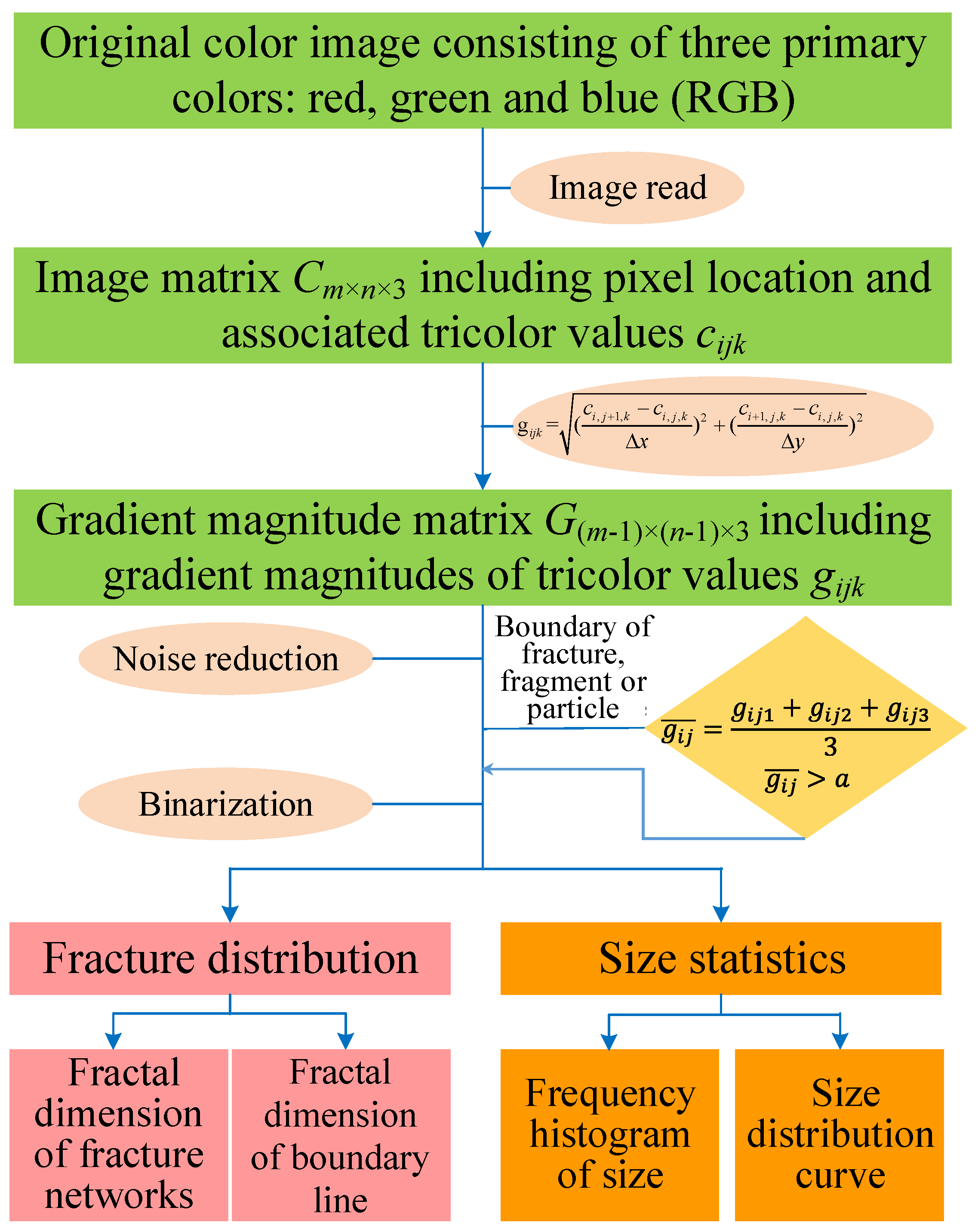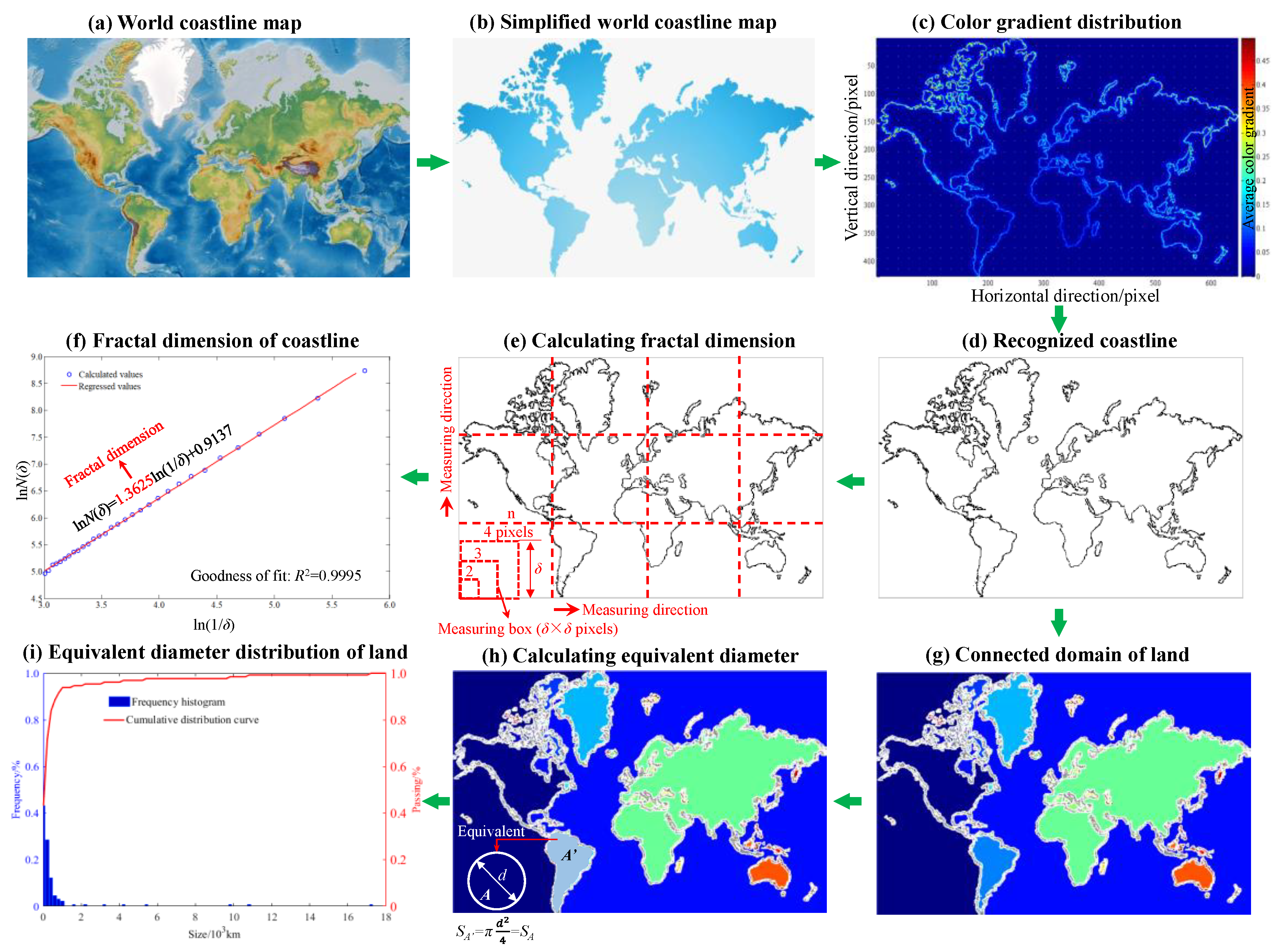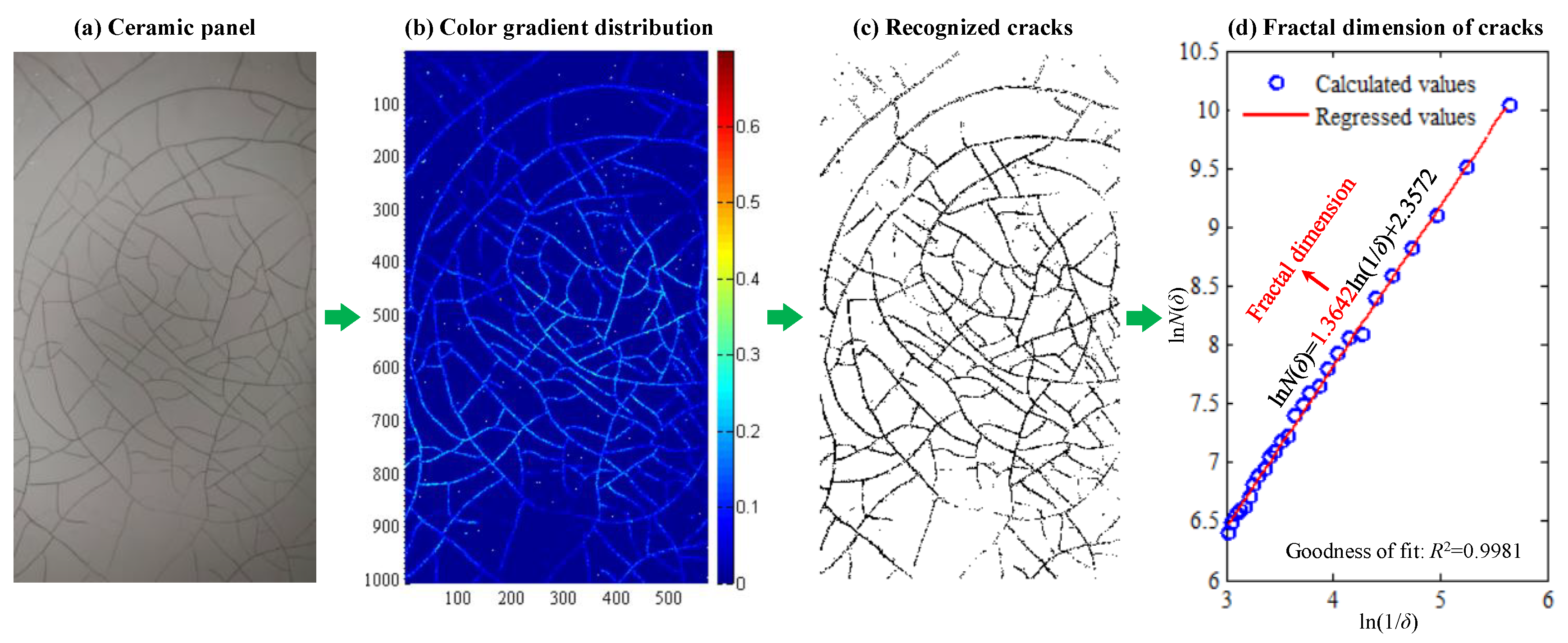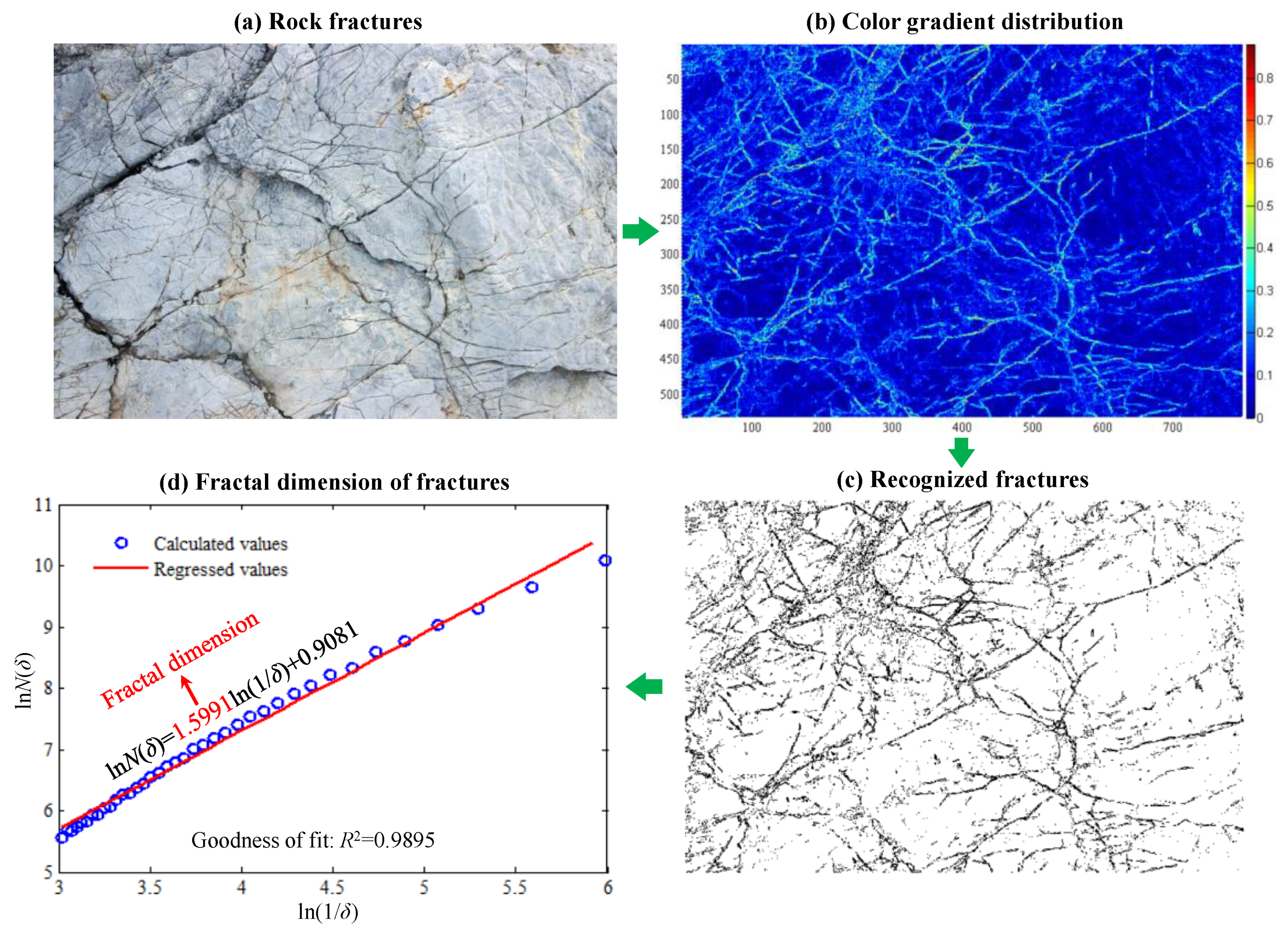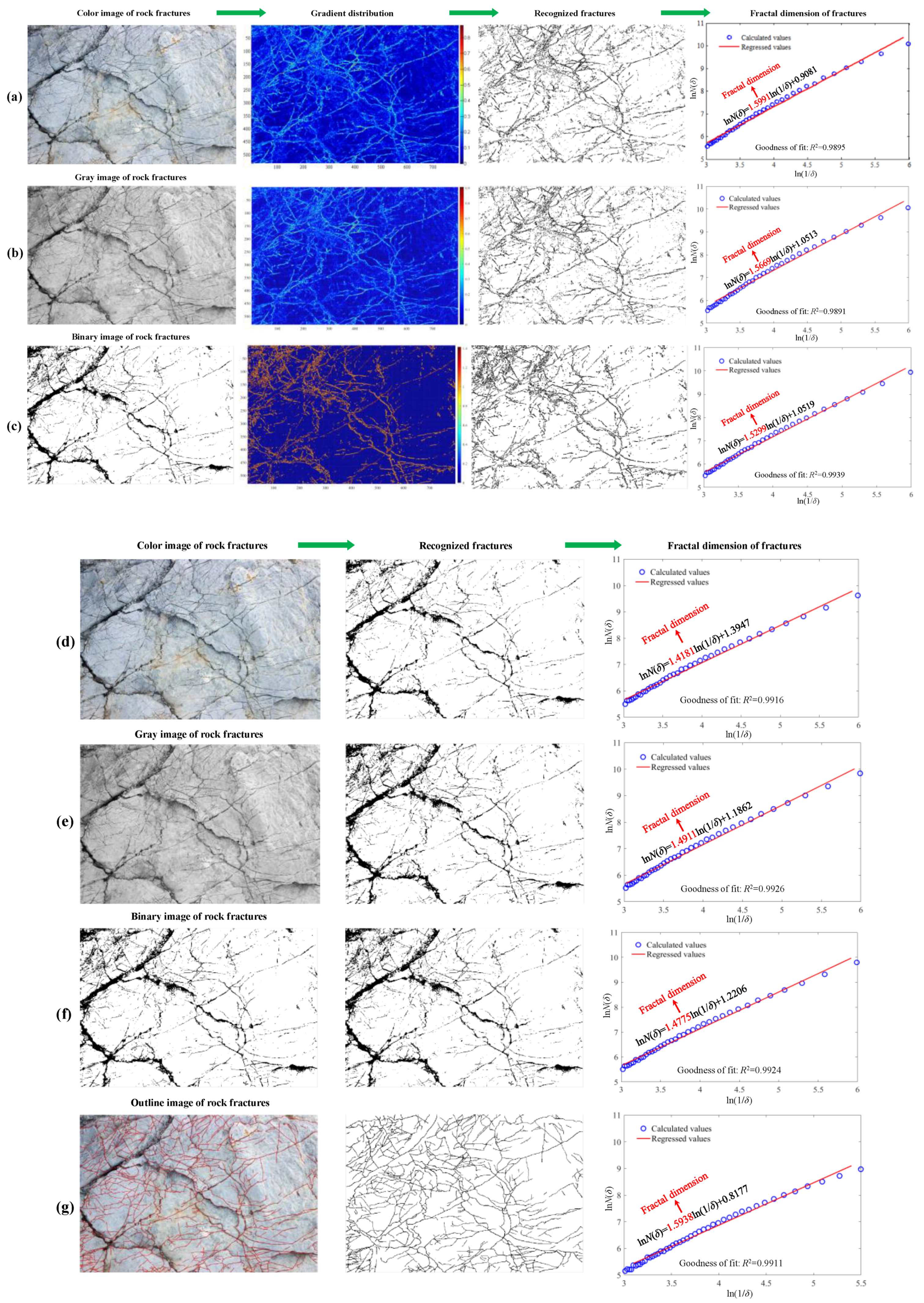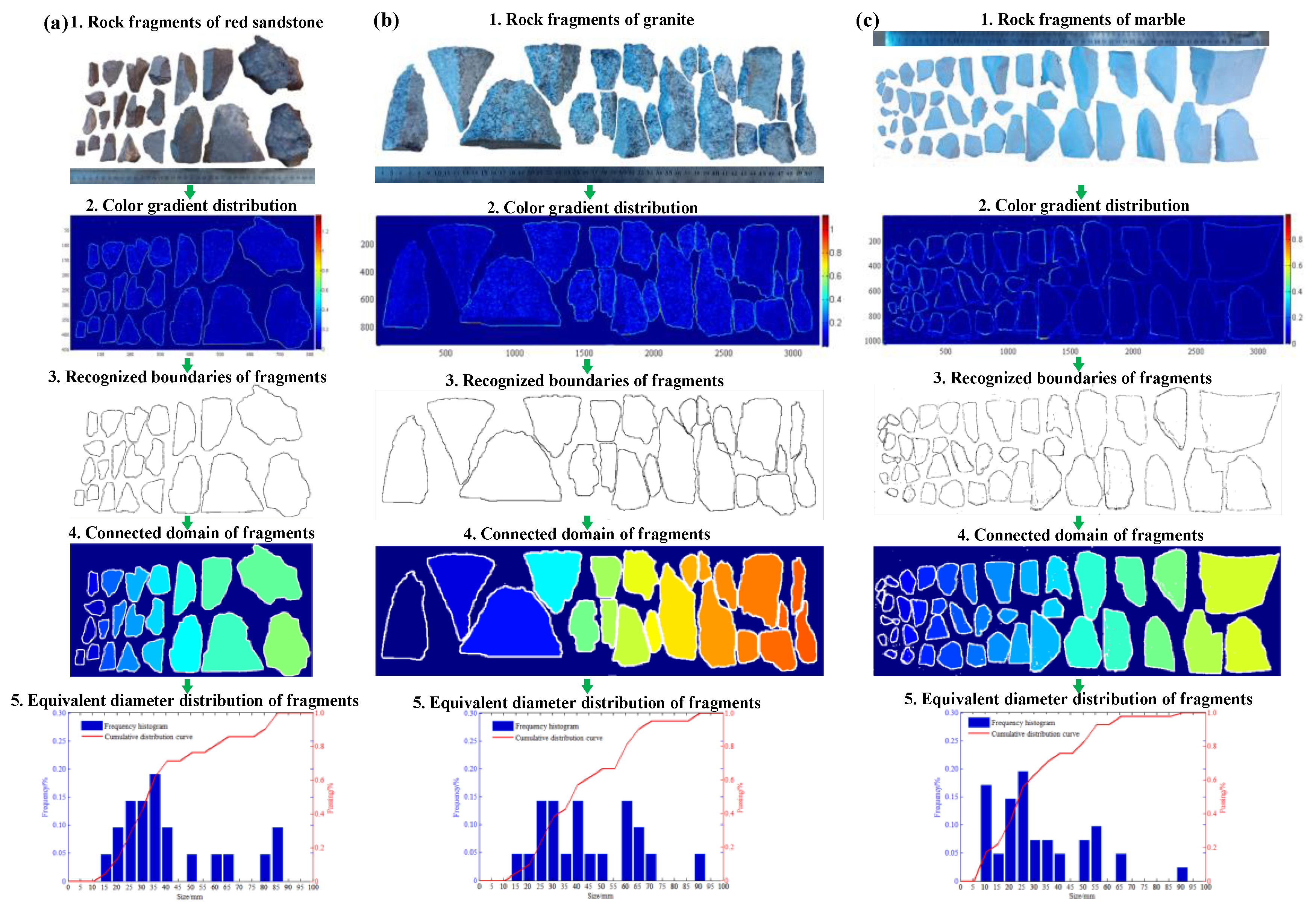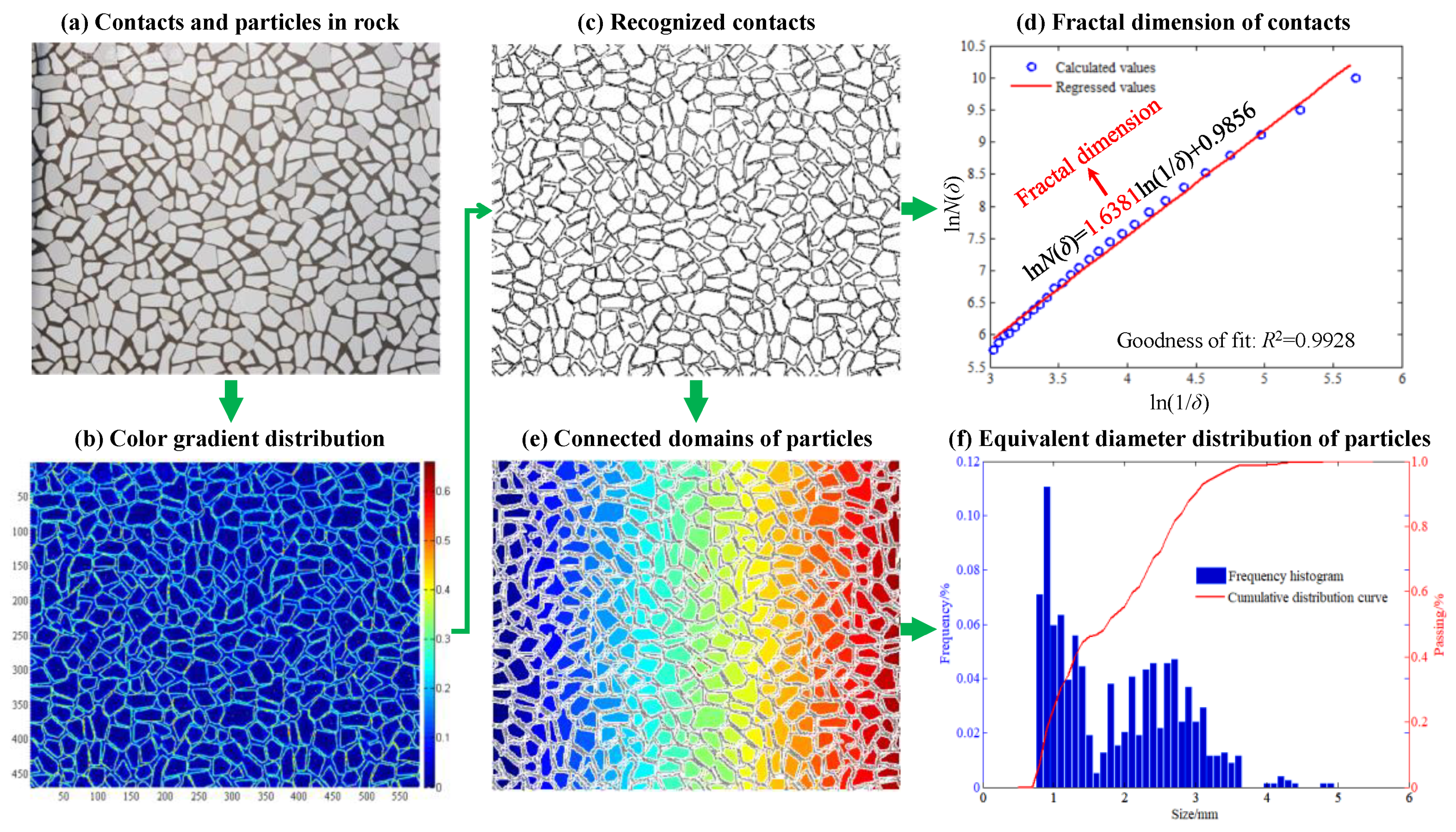1. Introduction
Natural geomaterials (soil and rock) and the associated artificial materials have many discontinuous structures such as cracks, fractures, and contacts and possibly produce fragments or particles during geological, environmental, and stress conditions [
1,
2,
3,
4,
5,
6,
7]. The distributions of discontinuous structures and particles can determine the physical-mechanical characteristics and failure modes of these materials. The size distribution of fragments reflects the failure behavior or breakage performance. Characterizations of discontinuous structures, particles, and fragments are important for many operations in mining and geotechnical fields, such as geo-mechanical assessment and stability analysis of rock mass, performance analysis of rock breakage, and geometrical characterization of the internal structure of rock-like material. Digital image processing is a digital-based and computer-based approach applying various mathematical algorithms to extract significant information from the images. Digital image processing has been widely used in a range of engineering topics in recent years to determine the characteristics of microscopic and macroscopic structures in the natural and human-made materials [
8].
Many efforts have been made to collect and characterize discontinuous structures in rock exposures. Customarily, handheld equipment such as a geological compass-clinometer, a measuring tape, and a roughness profile gauge were used to make the in situ measurement of discontinuity geometry of rock mass exposures. This method was undesirable for several reasons: high operation risk, limited measurement scale, high time consumption, and no uninterpreted record of the rock face. As an alternative approach to in situ measurement, photogrammetry allows for discontinuity geometry to be measured from remotely sensed photographs of rock mass exposures [
9,
10]. Afterwards, digital images were used instead, which promoted the production of automated methods to firstly detect discontinuities and to then analyze discontinuity geometry as the data comprising digital images can be mathematically processed [
11]. Some digital image processing techniques, such as the greyscale threshold, greyscale smoothing, segmentation, and edge detection, have been used to identify discontinuity traces in digital images of rock mass exposures to characterize the fracture length, orientation, and position [
11,
12,
13]. In these efforts, it was difficult to fully reflect the information of the natural rock mass exposure with gray-level images. The complication of the recognition of discontinuity traces defined by edges resulted in the binary image from segmentation containing a large number of error pixels. The optimal threshold value for each image impeded the creation of an automatic mapping tool [
14]. The manual, automatic, and semiautomatic methods had been used to characterize discontinuity traces using photographs of rock exposures, and the case studies on actual rock images were taken to conduct comparative analyses to quantify the accuracy of fracture detection and characterization [
11,
14]
Fragmentation is an important operation in order to control and minimize the loading, hauling, crushing, classification, and processing costs in mining and minerals engineering [
15,
16,
17,
18]. Many methods based on photo-analysis were proposed to estimate the size distribution of rock fragments [
19,
20,
21,
22]. The aforementioned methods were performed by hand or through image processing techniques by computer, which must delineate the individual rock fragments in an image. A computer program using statistical procedures was developed to automatically determine the size distribution of rock fragments based on high-resolution images [
23]. Subsequently, digital image software was developed to evaluate fragmentation, which gradually became a worldwide accepted tool in the mining and mineral processing industries with the emergence of the continuous fragmentation monitoring system [
24]. Some scholars compared fragmentation measurements using photographic and image analysis techniques on the actual images of fragments. They found that the photographic method was time-consuming, and manual editing was required to improve the accuracy of the image processing method [
25]. The image analysis approaches could reach a satisfactory accuracy via comparisons with calculations from manual outlining and measurement [
23,
24,
25].
The aforementioned methods based on image analyses provide useful tools for estimating the fracture and block size distributions. However, there is still a lack of a comprehensive and consolidated method to automatically recognize discontinuous structures and to characterize the distributions of discontinuous structures and block sizes with multiple scales. In addition, the graying process decreases the dimensionality of multicolor images and reduces recognition accuracy, although it is a common process in demarcations based on image processing techniques. This study proposed a digital image processing method based on the color gradient distribution of a multicolor image. This approach was used to automatically recognize the outlines of fractures/cracks/contacts, fragments, and particles. Then, the fracture network, block size distribution, and particle size distribution were quantitatively characterized. Case studies were conducted to confirm the proposed method.
2. Methodology
2.1. Image Processing Method Based on Color Gradient
The colors of fractures in rock and the outlines of rock fragments or particles are different from the colors of other zones in a digital image. There are high color gradient values at rock fractures and the outlines of rock fragments or particles. Therefore, a color gradient-based image processing method was proposed to automatically recognize the outlines of rock fractures, rock fragments, and rock particles. Then, the fractal dimension of the fracture network in rocks and the particle size distribution of rock fragments or particles can be characterized. The detailed steps are shown in
Figure 1 and described as follows:
Step 1—Read the original color image consisting of three primary colors (red, green, and blue) to produce an image matrix expressed as Equation (1) including pixel locations and the associated tricolor values.
where
is the image matrix and
is the tricolor value of a pixel.
Step 2—Calculate the color gradient based on Equation (2) to achieve a gradient magnitude matrix expressed as Equation (3), including gradient magnitudes of tricolor values. In addition, the isolated pixel with a peak value of color gradient will be deleted for simple noise reduction. The box with
pixels was used to find the insolated pixel with a peak value of color gradient by one pixel as the set size in the search. If the color gradient in the center position presents a sudden rise, this pixel will be considered noise.
where
is the gradient magnitude,
is the gradient magnitude matrix, and
and
are the differential steps in the horizontal and vertical directions for calculating the gradient magnitude, in which the steps are set to one pixel in the horizontal and vertical directions.
Step 3—Outline the rock fractures or the boundaries of rock fragments or particles, and use binarization to store the locations of outlines in a binary digital image according to the color gradient magnitude and the following criteria:
where
is the mean of the gradient magnitude values of the tricolor values and
a is the threshold value to recognize the outline.
Step 4—Calculate the fractal dimension of the fracture network in rock to quantitatively characterize the developmental degree of fractures in rock. The box-counting dimension is used to determine the fractal property of the fracture network. The binarized image is covered by a sequence of square grids with ascending sizes through a measuring box scale along the horizontal and vertical measuring directions. For each grid, the number of boxes intersected by the fracture network,
N(
δ), and the lengths of the sides of the boxes,
δ, are recorded. Then, the natural logarithm of
N(
δ) is plotted against the natural logarithm of 1/
δ and the straight line is regressed by Equation (6). The slope of the regressed straight line is the fractal dimension,
DF.
where
C is a regressed constant.
Step 5—Calculate the area,
, of the connected zone enclosed by each outline of the rock fragment or rock particle, and convert
into the equivalent diameter
of a circle for which the area
is equal to the area enclosed by outline, which can be expressed as
Then, the frequency histograms and distribution curves of equivalent diameters of the rock fragments or rock particles can be drawn from the size statistics.
2.2. Description of the Proposed Image Processing Method
In order to clearly describe the proposed image processing method, the calculation processes of the fractal dimension of the world coastline and the size distribution of the connected land were taken as the example shown in
Figure 2. The calculation process was similar to the analyses of the fractal dimension and the size distribution of rock fractures, rock fragments, or rock particles. First, the world coastline map (
Figure 2a) was simplified into a graph (
Figure 2b), with the different colors denoting seawater and land, by marking seawater and land with blue and white, respectively, using a drawing software. Secondly, the mean of the color gradient was calculated and drawn in the color gradient distribution graph shown in
Figure 2c. Then, the coastline was recognized and located in a binary digital image shown in
Figure 2d. Finally, the fractal dimension of the coastline was obtained using the regression analysis (
Figure 2f) of the box-counting dimension. The schematic diagram of the measuring process for calculating the box-counting dimension is shown in
Figure 2e. Meanwhile, the connected domain of land (
Figure 2g) was distinguished. The areas of connected domains were calculated and stored in a vector to obtain the frequency histogram and cumulative distribution curve (
Figure 2i) of land sizes by calculating equivalent diameter, as shown in
Figure 2h. The fractal dimension of world coastline is 1.3625, and the land sizes are mostly distributed below 2000 km, as determined by analyses from the proposed digital image processing method.
3. Application of the Proposed Image Processing Method
3.1. Fractal Dimension of Fracture Network
Rock and soil materials often produce a crack or fracture network under loads from geological and environment effects. It is an important task to characterize the fracture network to quantitatively determine the development and distribution of fractures. For the soil material of a mud layer under water, many cracks (
Figure 3a) will emerge after the water recedes, induced by tensile stress generated from water evaporation, thermal expansion, and cold shrinkage under high temperatures and drought conditions. The proposed image-processing method was used to determine the fractal dimension of cracks in the dry mud layer. The calculation process is shown in
Figure 3. The result shows that the fractal dimension of cracks in the dry mud layer is 1.4332.
For a ceramic panel that is a brittle material made by artificial sintering of clay, the crack network (
Figure 4a) will be produced by thermal expansion and cold shrinkage during high-temperature sintering and long-term service conditions. As shown in
Figure 4, the proposed image processing method was used to determine the fractal dimensions of the crack network in the ceramic panel. The calculated fractal dimension is 1.3642.
For the rock mass, there are many cracks or fractures (
Figure 5a) due to geological processes including tectonics, weathering, and diagenesis, and the effects of human-made excavation. It is important for quality assessments, strength prediction, and stability analysis of rock masses to characterize the fracture distribution. As shown in
Figure 5, the proposed method was used to determine the fractal dimension of the fracture network in rock mass based on the color gradient-based processing of a digital image of a natural rock mass. By distinguishing the color differences of rock fractures from color gradient distribution, the rock fractures were recognized from the natural rock mass. The fractal dimension of the fracture network regressed to 1.5991.
The aforementioned application examples show that the proposed image-processing method based on the color gradient distribution of a digital image can automatically and programmatically recognize cracks or fractures. Then, the associated fractal dimension of the crack or fracture network in soil and rock materials can be calculated. The results can provide quantitative information to determine the distribution characteristics and development degree of cracks or fractures in soil and rock materials.
In order to compare the proposed methodology with the existing methods, the aforementioned actual image of fracture network shot from the on-site rock mass were used to produce the calculation time and fractal dimensions by different image processing methods. The results were compared to the real situation by manual outlining, which can be regarded as a real result of fractal dimension. In the comparisons, the color gradient-based method proposed in this study was compared with the gray gradient-based, binary gradient-based, color image-based, gray image-based, and binary image-based methods. Finally, the proposed method was confirmed by manual outlining and the color-based method. The gradient-based methods were based on the gradient distribution of color, gray, or binary values for outlining the fracture network. The image-based methods were based on the tricolor, gray, or binary values for outlining the fracture network. The used computer was installed with Windows 10 × 64 system, Intel(R) Core(TM) i5-6200U CPU 2.30 GHz and RAM 8 GB. The comparative results are shown in
Figure 6 and summarized in
Table 1. Manual outlining can provide the real value of fractal dimension for conducting comparisons. However, the work outlining the fracture consumed four hours, which was a time-consuming and laborious task. Therefore, the image-processing methods were created to solve such a problem. The color gradient-based method proposed in this study consumed the longest calculation time for fracture identification and fractal dimension because it was required to determine the tricolor and the associated gradient. Nevertheless, it only took 1490.733 ms to produce the results. The results of fracture network and its fractal dimension achieved by the proposed color gradient-based method were closest to the results obtained by manual outlining. The difference rate was only 0.33%. Therefore, the calculation accuracy and calculation efficiency of the proposed method were confirmed by the comparisons.
3.2. Block Size Distribution of Rock Fragments
A number of rock fragments with multiple shapes and sizes will be produced when rock failure occurs in rock mechanical experiments and field excavations. The block size distribution of rock fragments is an important parameter for estimating the energy consumption characteristic of a rock after peak strength. The digital image processing approach was proposed to calculate the block size distribution of rock fragments. Firstly, the boundaries of rock fragments will be drawn and stored in a binary color matrix using the recognition criterion based on the color gradient distribution of the original image of rock fragments. Then, the areas of the connected domains surrounded by fragment boundaries were calculated, and these areas were converted into circles with the same area values and equivalent diameters. Finally, the frequency histogram and cumulative distribution curve of the equivalent diameters of rock fragments can be achieved. Granite, marble, and sandstone, which are classified as magmatic, metamorphic, and sedimentary rocks, respectively, are commonly used rock specimens for investigating the mechanical properties of brittle materials. Therefore, rock fragments of red sandstone, granite, and marble were used as application examples to show the specific processes of the proposed image processing approach to characterize the block size distribution, as shown in
Figure 7. The analysis results show that the equivalent diameters of fragments are mainly distributed in the ranges of 20–40 mm, 25–65 mm, and 10–35 mm for red sandstone, granite, and marble, respectively, under the same experimental conditions. Although the main distribution range of fragment diameter can be reflected, the distribution modality of fragment diameters did not present a special strict type with unimodality, bimodality, or multimodality because the number of fragments was few and did not have the statistical law. In addition, the randomness of rock fracturing also contributed to that result.
Based on the proposed image processing approach, the boundaries of the rock fragments can be clearly recognized and the connected domains can be accurately demarcated. Then, an accurate frequency histogram and cumulative distribution curve of equivalent diameters can be automatically produced to conduct visualization of the block size distribution of rock fragments. Therefore, the proposed method can be used to characterize the block size distributions of rock fragments produced during opencast blasting, underground mining, tunneling, ore-rock crushing, etc.
3.3. Fractal Dimension and Particle Size Distribution of Microparticles in Rock
Rocks are formed by cementation of many microparticles, influenced by long-term geological processes. The types, shapes, sizes, and distribution and cementation characteristics of microparticles determine the physical-mechanical properties of rock material. The fractal dimension of contacts between microparticles can reflect the shapes and the associated distribution of microparticles in rock. The equivalent diameter of particles and the associated distribution can characterize the particle size distribution in rock. The proposed digital image processing method can be simultaneously used to calculate the fractal dimension of contacts and the particle size distribution of microparticles in rock, as shown in
Figure 8. Based on the color gradient distribution, the contacts between microparticles can be recognized, and then the connected domains of microparticles can be demarcated. Then, the fractal dimension of contacts and the equivalent diameter distribution of particles can be produced by using the calculation processes of the box-dimension and equivalent diameter. The analysis results show that the fractal dimension of the contacts is 1.6381. The equivalent diameters of the microparticles are mainly distributed from 0.8–3.6 mm with a bimodality distribution, which means the sizes of microparticles are concentrated near 1 mm and 2–3 mm for the mentioned rock material. The reason for that bimodality may be determined by the mineral particle composition, bonding form, and special geological conditions of diagenesis. That result indicated that the particle elements with sizes of 1 mm and 2–3 mm be produced and reserved during the long process of diagenesis.
4. Conclusions
A digital image-processing method based on color gradient distribution was proposed to automatically recognize the outlines of rock fractures, rock fragments, and rock particles. By using this method, the fracture network, block size distribution, and particle size distribution of rock can be quantitatively characterized. The proposed approach can automatically produce the fractal dimension of a fracture or contact network in rock and the size distribution curves of rock fragments and mineral particles. These approaches can quantitatively characterize the rock structure characteristics by means of a computer. Based on this study, the following conclusions can be drawn:
(a) The calculation examples show that the proposed image-processing method can automatically and programmatically recognize cracks or fractures and then calculate the fractal dimensions of crack or fracture networks. The fractal dimension can quantitatively reflect the distribution characteristic and development degree of cracks or fractures in soil and rock materials. The calculation results show that the fractal dimensions of cracks in the dry mud layer, ceramic panel, and natural rock mass are 1.4332, 1.3642, and 1.5991, respectively.
(b) The outlines of rock fragments produced after rock failure can be clearly recognized by the proposed image-processing method. Then, the frequency histogram and cumulative distribution curves of equivalent diameters of rock fragments can be automatically obtained to characterize the block size distribution of rock fragments. The proposed method can be used to characterize the block size distributions of rock fragments produced in rock fragmentations during opencast blasting, underground mining, tunneling, and ore-rock crushing. The calculation examples show that the equivalent diameters of fragments of red sandstone, granite, and marble produced in compression failures are mainly distributed in the ranges of 20–40 mm, 25–65 mm, and 10–35 mm, respectively.
(c) Based on the proposed method, the contacts between microparticles in rock can be accurately recognized, and the connected domains of microparticles can be demarcated subsequently. Then, the fractal dimension of contacts and the equivalent diameter distribution of particles can be calculated and are 1.6381 and 0.8–3.6 mm, respectively, for the mineral particles in the rock specimens.
(d) The comparative analyses show that the proposed color gradient-based method presents the best performance and is closest to the actual result assessed by manual outlining. Compared to the existing methods, the proposed method is a comprehensive and consolidated approach that can automatically recognize discontinuous structures and characterize the distributions with multiple scales. Meanwhile, this approach fully utilizes multicolor information in color images. The above improvement significantly increases the recognition accuracy.
Author Contributions
Conceptualization, S.W.; methodology, Z.P.; validation, S.W.; formal analysis, Z.P.; writing—original draft preparation, Z.P.; writing—review and editing, S.W.; supervision, X.L. and Z.Z.; funding acquisition, S.W. All authors have read and agreed to the published version of the manuscript.
Funding
This research was funded by the National Natural Science Foundation of China, grant number 51904333.
Institutional Review Board Statement
Not applicable.
Informed Consent Statement
Not applicable.
Acknowledgments
The work described in this paper was supported by the National Natural Science Foundation of China (No. 51904333), for which the authors are very thankful.
Conflicts of Interest
The authors declare no conflict of interest.
References
- Wang, S.; Li, X.; Wang, S. Separation and fracturing in overlying strata disturbed by longwall mining in a mineral deposit seam. Eng. Geol. 2017, 226, 257–266. [Google Scholar] [CrossRef]
- Dai, B.; Chen, Y.; Zhao, G.; Liang, W.; Wu, H. A Numerical study on the crack development behavior of rock-like material containing two intersecting flaws. Mathematics 2019, 7, 1223. [Google Scholar] [CrossRef]
- Ran, X.; Xue, L.; Zhang, Y.; Liu, Z.; Sang, X.; He, J. Rock classification from field image patches analyzed using a deep convolutional neural network. Mathematics 2019, 7, 755. [Google Scholar] [CrossRef]
- Ye, X.; Wang, S.; Li, Q.; Zhang, S.; Sheng, D. The negative effect of installation on the performance of a compaction-grouted soil nail in poorly graded Stockton Beach Sand. J. Geotech. Geoenviron. Eng. 2020, 146, 04020061. [Google Scholar] [CrossRef]
- Qiu, J.; Li, X.; Li, D.; Zhao, Y.; Hu, C.; Liang, L. Physical Model Test on the Deformation Behavior of an Underground Tunnel Under Blasting Disturbance. Rock Mech. Rock Eng. 2021, 54, 91–108. [Google Scholar] [CrossRef]
- Gao, K.; Li, S.; Han, R.; Li, R.; Liu, Z. Study on the propagation law of gas explosion in the space based on the goaf characteristic of coal mine. Saf. Sci. 2020, 127, 104693. [Google Scholar] [CrossRef]
- Cai, X.; Zhou, Z.; Zang, H.; Song, Z. Water saturation effects on dynamic behavior and microstructure damage of sandstone: Phenomena and mechanisms. Eng. Geol. 2020, 276, 105760. [Google Scholar] [CrossRef]
- Yue, Z.; Chen, S.; Tham, L. Finite element modeling of geomaterials using digital image processing. Comput. Geotech. 2003, 30, 375–397. [Google Scholar] [CrossRef]
- Brown, E.T. Rock Mass Characterisation Testing and Monitoring. ISRM Suggested Methods; Pergamon Press: Oxford, UK, 1981. [Google Scholar]
- Harrison, J.P. Improved Analysis of Rock Mass Geometry Using Mathematical and Photogrammetric Methods. Ph.D. Thesis, Imperial College, London, UK, 1993. [Google Scholar]
- Reid, T.R.; Harrison, J.P. A semi-automated methodology for discontinuity trace detection in digital images of rock mass exposures. Int. J. Rock Mech. Min. Sci. 2000, 37, 1073–1089. [Google Scholar] [CrossRef]
- Hagan, T.O. A case of terrestrial photogrammetry in deep-mine rock structure studies. Int. J. Rock Mech. Min. Sci. Geomech. Abstr. 1980, 15, 191–198. [Google Scholar] [CrossRef]
- Maerz, N. Photoanalysis of Rock Fabric. Ph.D. Thesis, University of Waterloo, Waterloo, ON, Canada, 1990. [Google Scholar]
- Lemy, F.; Hadjigeorgiou, J. Discontinuity trace map construction using photographs of rock exposures. Int. J. Rock Mech. Min. Sci. 2003, 40, 903–917. [Google Scholar] [CrossRef]
- Wang, S.; Sun, L.; Li, X.; Wang, S.; Du, K.; Li, X.; Feng, F. Experimental investigation of cuttability improvement for hard rock fragmentation using conical cutter. Int. J. Geomech. 2021, 21, 06020039. [Google Scholar] [CrossRef]
- Jiang, R.; Dai, F.; Liu, Y.; Li, A. Fast marching method for microseismic source location in cavern-containing rockmass: Performance analysis and engineering application. Engineering 2021. [Google Scholar] [CrossRef]
- Wang, S.; Li, X.; Yao, J.; Gong, F.; Li, X.; Du, K.; Tao, M.; Huang, L.; Du, S. Experimental investigation of rock breakage by a conical pick and its application to non-explosive mechanized mining in deep hard rock. Int. J. Rock Mech. Min. Sci. 2019, 122, 104063. [Google Scholar] [CrossRef]
- Du, K.; Li, X.; Tao, M.; Wang, S. Experimental study on acoustic emission (AE) characteristics and crack classification during rock fracture in several basic lab tests. Int. J. Rock Mech. Min. Sci. 2020, 133, 104411. [Google Scholar] [CrossRef]
- Ghosh, A.; Daemen, J.; van Zyl, D. Fractal based approach to determine the effect of discontinuities on blast fragmentation. In Proceedings of the 31st U.S. Symposium on Rock Mechanics (USRMS), Golden, CO, USA, 18–20 June 1990. [Google Scholar]
- Hunter, G.; McDermott, C.; Miles, N.; Singh, A.; Scoble, M. Review of image analysis techniques for measuring blast fragmentation. Min. Sci. Technol. 1990, 11, 19–36. [Google Scholar] [CrossRef]
- Liu, M.; Liu, J.; Zhen, M.; Zhao, F.; Liu, Z. A comprehensive evaluation method of bench blast performance in open-pit mine. Appl. Sci. 2020, 10, 5398. [Google Scholar] [CrossRef]
- Mojtabai, N.; Farmer, I.; Savely, J. Optimization of rock fragmentation in bench blasting. In Proceedings of the 31st U.S. Symposium on Rock Mechanics (USRMS), Golden, CO, USA, 18–20 June 1990; pp. 897–904. [Google Scholar]
- Kemeny, J.; Devgan, A.; Hagaman, R.; Wu, X. Analysis of rock fragmentation using digital image processing. J. Geotech. Eng. 1993, 119, 1144–1160. [Google Scholar] [CrossRef]
- Sanchidrian, J.; Segarra, P.; Lopez, L. A Practical Procedure for the Measurement of Fragmentation by Blasting by Image Analysis. Rock Mech. Rock Eng. 2006, 39, 359–382. [Google Scholar] [CrossRef]
- Sudhakar, J.; Adhikari, G.; Gupta, R. Comparison of Fragmentation Measurements by Photographic and Image Analysis Techniques. Rock Mech. Rock Eng. 2006, 39, 159–168. [Google Scholar] [CrossRef]
Figure 1.
Flowchart of the image-processing method for analyzing the properties of rock fracturing and block/particle size distribution.
Figure 1.
Flowchart of the image-processing method for analyzing the properties of rock fracturing and block/particle size distribution.
Figure 2.
Description of the image-processing method for determining the fractal dimension of the world coastline and the size distribution of land, including (a) a world coastline map, (b) a simplified world coastline map, (c) color gradient distribution, (d) color gradient-based recognition of the coastline, (e) calculation process of the fractal dimension, (f) result of the fractal dimension of the coastline, (g) connected domain of land, (h) calculation process of equivalent diameter, and (i) the result of equivalent diameter distribution of land.
Figure 2.
Description of the image-processing method for determining the fractal dimension of the world coastline and the size distribution of land, including (a) a world coastline map, (b) a simplified world coastline map, (c) color gradient distribution, (d) color gradient-based recognition of the coastline, (e) calculation process of the fractal dimension, (f) result of the fractal dimension of the coastline, (g) connected domain of land, (h) calculation process of equivalent diameter, and (i) the result of equivalent diameter distribution of land.
Figure 3.
Fractal dimension of the crack network of the mud layer, including (a) cracks of the mud layer, (b) color gradient distribution, (c) recognized cracks, and (d) fractal dimension of the crack network.
Figure 3.
Fractal dimension of the crack network of the mud layer, including (a) cracks of the mud layer, (b) color gradient distribution, (c) recognized cracks, and (d) fractal dimension of the crack network.
Figure 4.
Fractal dimension of the crack network in a ceramic panel, including (a) cracks in the ceramic panel, (b) color gradient distribution, (c) recognized cracks, and (d) fractal dimension of the crack network.
Figure 4.
Fractal dimension of the crack network in a ceramic panel, including (a) cracks in the ceramic panel, (b) color gradient distribution, (c) recognized cracks, and (d) fractal dimension of the crack network.
Figure 5.
Fractal dimension of the fracture network in a rock mass, including (a) fractures in the rock mass, (b) color gradient distribution, (c) recognized fractures, and (d) fractal dimension of the fracture network.
Figure 5.
Fractal dimension of the fracture network in a rock mass, including (a) fractures in the rock mass, (b) color gradient distribution, (c) recognized fractures, and (d) fractal dimension of the fracture network.
Figure 6.
Calculation results of the fractal dimension of a fracture network by different methods, including (a) the color gradient-based method proposed in this study, (b) a gray gradient-based method, (c) a binary gradient-based method, (d) a color image-based method, (e) a gray image-based method, (f) a binary image-based method, and (g) a manual outlining and color-based method.
Figure 6.
Calculation results of the fractal dimension of a fracture network by different methods, including (a) the color gradient-based method proposed in this study, (b) a gray gradient-based method, (c) a binary gradient-based method, (d) a color image-based method, (e) a gray image-based method, (f) a binary image-based method, and (g) a manual outlining and color-based method.
Figure 7.
Block size distribution of rock fragments produced in rock mechanics tests, which include (a) red sandstone, (b) granite, and (c) marble.
Figure 7.
Block size distribution of rock fragments produced in rock mechanics tests, which include (a) red sandstone, (b) granite, and (c) marble.
Figure 8.
Fractal dimension and particle size distribution of microparticles in rock, including (a) contacts and particles in rock, (b) color gradient distribution, (c) recognized fractures between microparticles in rock, (d) fractal dimension of fractures, (e) connected domains of particles, and (f) the frequency histogram and cumulative distribution curve of particle sizes.
Figure 8.
Fractal dimension and particle size distribution of microparticles in rock, including (a) contacts and particles in rock, (b) color gradient distribution, (c) recognized fractures between microparticles in rock, (d) fractal dimension of fractures, (e) connected domains of particles, and (f) the frequency histogram and cumulative distribution curve of particle sizes.
Table 1.
Comparation of calculation methods.
Table 1.
Comparation of calculation methods.
| Method | Calculation Time for Fracture Identification and Fractal Dimension/ms | Fractal Dimension | Difference Rate of Fractal Dimension Relative to the Result by Manual Outlining/% |
|---|
| Color gradient-based method proposed in this study | 1490.733 | 1.5991 | 0.33 |
| Gray gradient-based method [11] | 1003.207 | 1.5669 | 1.69 |
| Binary gradient-based method [11] | 1187.949 | 1.5299 | 4.01 |
| Color image-based method (designed in this study for comparison) | 196.739 | 1.4181 | 11.02 |
| Gray image-based method | 143.722 | 1.4911 | 6.44 |
| Binary image-based method [14] | 155.167 | 1.4775 | 7.3 |
| Manual outlining and color-based method (designed in this study for comparison) | 157.846
(Before it, the outlining time has 4 h) | 1.5938 | -- |
| Publisher’s Note: MDPI stays neutral with regard to jurisdictional claims in published maps and institutional affiliations. |
© 2021 by the authors. Licensee MDPI, Basel, Switzerland. This article is an open access article distributed under the terms and conditions of the Creative Commons Attribution (CC BY) license (https://creativecommons.org/licenses/by/4.0/).
